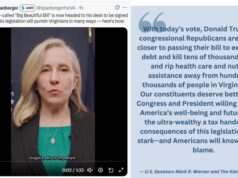 Another statement by Eric Cantor — this time that health care reform legislation passed last year is “job killing” – another “false” rating by PolitiFact.
Another statement by Eric Cantor — this time that health care reform legislation passed last year is “job killing” – another “false” rating by PolitiFact.
Republicans have used the “job-killing” claim hundreds of times — so often that they used the phrase in the name of the bill. It implies that job losses will be one of the most significant effects of the law. But they have flimsy evidence to back it up.
The phrase suggests a massive decline in employment, but the data doesn’t support that. The Republican evidence is extrapolated from a report that was talking about a reduction in the labor supply rather than the loss of jobs, or based on measures that weren’t included in the final health care law. We rate the statement False.
So far, according to PolitiFact Virginia, Cantor has racked up 1 “true” statement, 1 “half true,” 2 “barely true,” 3 “false,” and 2 “pants on fire” lies. In other words, 8 of the 9 statements by Eric Cantor analyzed by PolitiFact are not fully or even “mostly” true, with only 1 being even HALF true. Can Eric Cantor simply not tell the truth? Is he a pathological liar? And what about all the other members of his caucus who go out there and repeat the “pants on fire” and “false” statements every day? It’s disgusting, but as the saying goes, “fool me once, shame on YOU, fool me twice, shame on ME!” When it comes to Republicans and their factually-challenged commments, let the buyer beware…
P.S. Keep in mind that PolitiFact is NON-partisan. Of course, so is the Congressional Budget Office, but that hasn’t stopped Republicans from simply waving away findings they don’t like. It must be nice to live in a world of “magical thinking,” make-believe, tooth fairies, and ponies for everyone.












